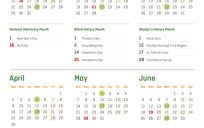Crossposted from The Design State
When I get involved in a new project, whether it is a completely new site or a redesign, the first thing I do is analyze the content & content expectations of the client and try to figure out the best way to organize things so that the correct information is easy to find, and the important information makes sure that it can be found. Where this gets complicated is when there are differing ideas as to what constitutes important or correct content. So, communication is a key part of the content analysis process. I’m going to skip talking about that piece, assuming that y’all know how to effectively communicate, and instead I’m going to focus on some of the pitfalls of content organization and a few ways you can make your content more user-friendly on the home page of your site.
Content that weighs too little
You’ve seen it. The site with no useful information on it. A site where the home page consists of a mission statement and the navigation links to pages describing services provided by the office, but no details are available, and little reason to return to the site after grabbing a telephone number or address. Typically these sites are from the early days of the WWW, when people were still figuring out what a website was for. They’re essentially web presences, not proper sites, but just something minimal that directs people to call or come visit.
When you’re dealing with a site that weighs too little, the first thing to do is identify what the agency does and figure out which of those things can be better translated into web content. It’s easier than you think. Here are some things to ask yourself or your client:
- Do you have regular meetings that are open to the public? (Put up a calendar with agenda and minutes)
- Do you have forms or applications that your citizens will need to use? Can any of them be filled out online? (Post PDFs (interactive ones if you’ve got the ability) or create online forms that can be filled out and submitted at the citizen convenience)
- Are there questions you get regular calls about? (Put up a FAQ)
- Are there specific programs that could use a little publicity?
- Are there reports (annual or otherwise) that could be put online for citizens to view?
- Is there a staff page listing contact information for various departments within the agency?
- Is there a contact form?
It is surprising how much content you can get from asking these few questions. Basically, anything an agency does can be translated to a website in one way or another. If the resources are available it is even better if you can make some of these processes interactive, and user-friendly enough to reduce the weight of red tape and bureaucratic turnaround.
Content that weighs too much
On the other hand, there’s the site where the agency has gotten the point about putting content out there, but doesn’t have a clear plan on organizing, displaying or distributing it. What you can end up with here is a rabbit-hole of pages and no clear direction regarding where you are or how you got there (adding breadcrumbs is only one part of solving this issue), long paragraphs of text with no distinguishing characteristics, and inconsistent organization of programs, forms, policies and other information. This site is the result of content accretion, a bit like your junk drawer (or closet as the case may be). What you need is in there, but it might be at the bottom of the pile, or else somehow ended up in your bowling ball bag. When you’re dealing with one of these monstrosities, this time you need an ordered list to follow:
- Dig through the site, the whole thing. Have a piece of note paper handy to write down your general ideas for content groupings. By department, program, clientele or a combination of all three? Is there some other way of organizing the content into a meaningful hierarchy?
- Identify sections that can be split into subsections. Are all of the programs on one page? Make a page for each one.
- Remove unnecessary or outdated content. Is the mission statement at the top of every page? Put it on the About Us page. Is there a notice for an event that has long since passed? An advisory or press release that no longer needs to be prominent? Create an organized, searchable archive for these items.
- Design your page layout and keep it consistent. Use HTML headings to help users separate content into sections, name consistent sections consistently (e.g. Forms, Contact Info). Don’t be afraid to use different font sizes, bold, or italics, but don’t over use them either.
- Make sure that the most important thing sticks out the most.
- Make sure that everything doesn’t end up being the most important thing. Prioritize.
- Use your home page to collect all of the important things from the rest of the site. Prioritize and distinguish these items in the same way.
- Keep your eyes on the goal: you’re organizing the site for your citizens, strike a balance between what is important to internal stakeholders and external ones, but prioritize for the people who visit the site to use your services.
If you go through this list (and I’m sure it can be added to and adapted) you should have a better idea of how to wrestle your site’s content and pin it just where you’d like it to be.




Content is still king….design is heavily important but with nothing good design can’t hide it. But at the same time too much information doesn’t work…I really like these tips.